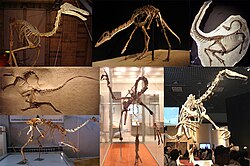|
Ornitomimosauria, ornitomimosaurus ("kadal mimik-burung") atau dinosaurus burung unta[7] adalah dinosaurus theropoda yang menyerupai burung unta modern. Dinosaurus ini merupakan dinosaurus omnivor atau herbivor yang dapat bergerak cepat. Dinosaurus ini hidup pada masa Kapur di Laurasia (kini Asia, Eropa, dan Amerika Utara), Afrika, dan kemungkinan Australia.[8] Kelompok ini pertama kali muncul pada masa Kapur Awal dan dapat bertahan hingga masa Kapur Akhir. Beberapa genus yang termasuk dalam kelompok ini adalah Nqwebasaurus, Pelecanimimus, Shenzhousaurus, Hexing, dan Deinocheirus, dengan panjang lengan yang mencapai 2,4 m. Terdapat pula famili Ornithomimidae, dan di dalamnya terdapat genus Gallimimus, Struthiomimus, dan Ornithomimus. Beberapa paleontolog (seperti Paul Sereno) menganggap Alvarezsauridae sebagai kerabat dekat ornitomimosaurus dan mengklasifikasikan keduanya ke dalam superfamili Ornithomimoidea.
Catatan kaki
- ^ a b Holtz, Thomas R. Jr. (2012) Dinosaurs: The Most Complete, Up-to-Date Encyclopedia for Dinosaur Lovers of All Ages, Winter 2011 Appendix.
- ^ a b Brownstein CD. (2016) Redescription of Arundel formation Ornithomimosaur material and a reinterpretation of Nedcolbertia justinhofmanni as an "Ostrich Dinosaur": Biogeographic implications. PeerJ Preprints 4:e2308v1 https://doi.org/10.7287/peerj.preprints.2308v1
- ^ Jin Liyong, Chen Jun & Pascal Godefroit (2012). "A New Basal Ornithomimosaur (Dinosauria: Theropoda) from the Early Cretaceous Yixian Formation, Northeast China". Dalam Godefroit, P. Bernissart Dinosaurs and Early Cretaceous Terrestrial Ecosystems. Indiana University Press. hlm. 467–487.
- ^ Choiniere, J. N.; Forster, C. A.; De Klerk, W. J. (2012). "New information on Nqwebasaurus thwazi, a coelurosaurian theropod from the Early Cretaceous (Hauteriverian?) Kirkwood Formation in South Africa". Journal of African Earth Sciences. 71-72: 1–17. doi:10.1016/j.jafrearsci.2012.05.005.
- ^ a b R. Allain, R. Vullo, J. Le loeuff & J.-F. Tournepiche (2014) European ornithomimosaurs (Dinosauria, Theropoda): an undetected record. Geologica Acta 12(2) (advance online publication) June 2014.
- ^ Lee, Y.-N.; Barsbold, R.; Currie, P.J.; Kobayashi, Y.; Lee, H.-J.; Godefroit, P.; Escuillié, F.; Chinzorig, T. (2014). "Resolving the long-standing enigmas of a giant ornithomimosaur Deinocheirus mirificus". Nature. 515: 1–4. doi:10.1038/nature13874. PMID 25337880.
- ^ "Ostrich dinosaurs".
- ^ "New information on Nqwebasaurus thwazi, a coelurosaurian theropod from the Early Cretaceous Kirkwood Formation in South Africa". Journal of African Earth Sciences. 71-72: 1–17. doi:10.1016/j.jafrearsci.2012.05.005.
Daftar pustaka
- Barrett, P. M. (2005). "The diet of ostrich dinosaurs (Theropoda: Ornithomimosauria)". Palaeontology. 48: 347–358. doi:10.1111/j.1475-4983.2005.00448.x.
- British Museum (Natural History): Ostrich Dinosaurs
- Jacobsen, A.R. 2001. Tooth-marked small theropod bone: An extremely rare trace. p. 58-63. In: Mesozoic Vertebrate Life. Ed.s Tanke, D. H., Carpenter, K., Skrepnick, M. W. Indiana University Press.
- Li Xu; Yoshitsugu Kobayashi; Junchang Lü; Yuong-Nam Lee; Yongqing Liu; Kohei Tanaka; Xingliao Zhang; Songhai Jia; Jiming Zhang (2011). "A new ornithomimid dinosaur with North American affinities from the Late Cretaceous Qiupa Formation in Henan Province of China". Cretaceous Research. 32 (2): 213–222. doi:10.1016/j.cretres.2010.12.004. [pranala nonaktif permanen]
- Molnar, R. E., 2001, Theropod paleopathology: a literature survey: In: Mesozoic Vertebrate Life, edited by Tanke, D. H., and Carpenter, K., Indiana University Press, p. 337-363.
- Nicholls, E. L.; Russell, A. P. (1985). "Structure and function of the pectoral girdle and forelimb of Struthiomimus altus (Theropoda: Ornithomimidae)". Palaeontology. 28: 643–677.
- Norell, M. A.; Makovicky, P.; Currie, P. J. (2001). "The beaks of ostrich dinosaurs". Nature. 412: 873–874. doi:10.1038/35091139. PMID 11528466.
- Schmitz, L. & Motani, R. (2011). "Nocturnality in Dinosaurs Inferred from Scleral Ring and Orbit Morphology". Science. 332 (6030): 705–8. doi:10.1126/science.1200043. PMID 21493820.
- Sereno, P. C. 2005. Stem Archosauria—TaxonSearch Diarsipkan 2009-01-15 di Wayback Machine. [version 1.0, 2005 November 7]
- Tanke, D.H. and Brett-Surman, M.K. 2001. Evidence of Hatchling and Nestling-Size Hadrosaurs (Reptilia:Ornithischia) from Dinosaur Provincial Park (Dinosaur Park Formation: Campanian), Alberta, Canada. pp. 206–218. In: Mesozoic Vertebrate Life—New Research Inspired by the Paleontology of Philip J. Currie. Edited by D.H. Tanke and K. Carpenter. Indiana University Press: Bloomington. xviii + 577 pp.
- Turner, A.H.; Pol, D.; Clarke, J.A.; Erickson, G.M.; Norell, M. (2007). "Supporting online material for: A basal dromaeosaurid and size evolution preceding avian flight". Science. 317 (5843): 1378–1381. doi:10.1126/science.1144066. PMID 17823350. (supplement)
|
